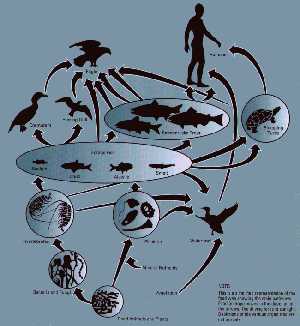Trophic Levels and Food ChainsThe biotic elements that comprise an ecosystem fall into one of several trophic levels. The trophic level of an organism is its position in a food chain, the sequence of consumption and energy transfer through the environment. For example, a simple grazing food chain is comprised of Plant -> herbivore -> carnivore Figure 12.15 Mushrooms are important for cycling nutrients through ecosystems. Courtesy U.S. Bureau of Land Management. At the base of the food chain lies the primary producers. Primary producers are principally green plants and certain bacteria. They convert solar energy into organic energy. Above the primary producers are the consumers who ingest live plants or the prey of others. Decomposers, such as, bacteria, molds, and fungi make use of energy stored in already dead plant and animal tissues. Fungi, like mushrooms, absorb nutrients from the organisms by secreting enzymes to break up the chemical compounds that make up dead plants and animals.
Two laws of physics are important in the study of energy flow through ecosystems. The first law of thermodynamics states that energy cannot be created or destroyed; it can only be changed from one form to another. Energy for the functioning of an ecosystem comes from the Sun. Solar energy is absorbed by plants where in it is converted to stored chemical energy. The second law of thermodynamics states that whenever energy is transformed, there is a loss energy through the release of heat. This occurs when energy is transferred between trophic levels as illustrated in a food web. When one animal feeds off another, there is a loss of heat (energy) in the process. Additional loss of energy occurs during respiration and movement. Hence, more and more energy is lost as one moves up through trophic levels. This fact lends more credence to the advantages of a vegetarian diet. For example, 1350 kilograms of corn and soybeans is capable of supporting one person if converted to beef. However, 1350 kilograms of soybeans and corn utilized directly without converting to beef will support 22 people! Assess your basic understanding of the preceding material by "Looking Back at Energy Flow Through Ecosystems" or skip and continue reading. |


